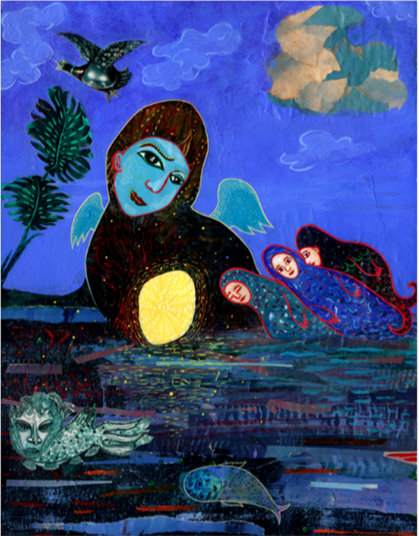Frisson d’enfants
Ikka no myoju en japonais signifie : « L’univers entier est une seule perle brillante. » Phrase célèbre dans les annales du zen du Maître Gensha, pour expliquer l’enseignement bouddhique.
Un jour le Maître Gensha dit ceci à un moine :
“Tu te débats pour te libérer dans la caverne des démons de la montagne noire. Moine, tu n’as pas pu comprendre que tout l’univers est une perle brillante. Tu as un peu compris, mais pas vraiment… Tu penses d’une manière intellectuelle; tu es empêché, par ta pensée, d’avoir la véritable compréhension intime et sans limites. Tout est une perle brillante, même l’antre des démons de la montagne noire.”
Dogen, maître zen japonais (1200-1253), commenta par la suite la fameuse histoire de la perle brillante : « Comment peut-on utiliser cet antre du démon de la montagne noire ? La caverne du démon de la montagne noire peut aussi être une perle brillante. Ton cerveau lui-même est une perle brillante. Ton esprit lui-même est une perle brillante, même la grotte du démon de la montagne noire.” Extrait du Le Shobogenzo (l’Oeil du Trésor de la vraie Loi.)
C’est souvent bien après que mes tableaux ont été créés que j’en perçois plus clairement la signification et l’origine. Dans l’image, Frisson d’enfants, le corps du canard est réellement constitué d’une énorme perle. La photo de l’oiseau est tirée d’une carte postale iranienne que j’ai achetée à l’âge de 14 ans à Téhéran, alors que mon père travaillait là-bas. J’adorais ce bijou qui fait partie de l’importante collection de joaillerie de la couronne impériale de Perse.
Ayant conservé durant toutes ces années la carte postale de l’oiseau, j’ai redonné au canard sa liberté dans le ciel de mon tableau.
Le monde entier dans les dix directions est une seule perle brillante : cela est symbolisé par l’oiseau libre comme le vent. Les trois personnages en tchador représentent trois femmes courageuses, mais qui sont en même temps terrorisées par le terrifiant voyage de l’âme qu’elles vont entreprendre jusqu’à la découverte de la clarté de leur propre esprit. On voit qu’elles luttent pour ne pas entrer dans la caverne du démon de la montagne noire où se trouve pourtant caché depuis toujours le joyau étincelant. Les éléments chimériques un peu inquiétants sommeillant sous l’eau ont servi antérieurement de vignettes dans mon livre, Shô et les dragons d’eau.
Cette image du Canard à la Perle a été utilisée par la suite pour illustrer la couverture du livre : Frisson d’enfants de l’écrivaine, Pauline Michel, éditions Xyz, Montréal, 2006
Children’s thrill
Ikka no myoju in Japanese means: “The whole universe is one brilliant pearl. A phrase famous in the annals of Master Gensha’s zen, to explain Buddhist teaching.
One day Master Gensha says this to a monk:
“You are struggling to free yourself in the cave of the demons of the black mountain, Monk, you could not understand that the whole universe is a brilliant pearl, you have understood a little, but not really … You think in an intellectual way, you are prevented by your thought from having true intimate and limitless understanding, everything is a brilliant pearl, even the den of the demons of the black mountain. ”
Dogen, Japanese Zen master (1200-1253), later commented on the famous story of the brilliant pearl: “How can we use this lair of the devil of the black mountain? The Devil’s Cave of the Black Mountain can also be a brilliant pearl. Your brain itself is a brilliant pearl. Your spirit itself is a brilliant pearl, even the cave of the devil of the black mountain. “Excerpt from The Shobogenzo (The Eye of the Treasure of the True Law.)
It is often long after my paintings have been created that I can more clearly see their meaning and origin. In the picture, Children’s Shiver, the body of the duck is actually made up of a huge pearl. The bird’s picture is taken from an Iranian postcard I bought at the age of 14 in Tehran while my father was working there. I loved this jewel that is part of the important jewelery collection of the imperial crown of Persia.
Having kept all these years the postcard of the bird, I gave the duck his freedom in the sky of my painting.
The whole world in the ten directions is one brilliant pearl: this is symbolized by the free bird as the wind. The three characters in chador represent three courageous women, who are at the same time terrorized by the terrifying journey of the soul that they will undertake until the discovery of the clarity of their own spirit. We see that they struggle not to enter the cave of the devil of the black mountain where has always been hidden forever the sparkling jewel. The somewhat disturbing chimerical elements slumbering underwater have previously served as thumbnails in my book, Shô and the Water Dragons.
This image of Duck with Pearl was used later to illustrate the cover of the book: Frisson d’enfants of the writer, Pauline Michel, editions Xyz, Montreal, 2006


